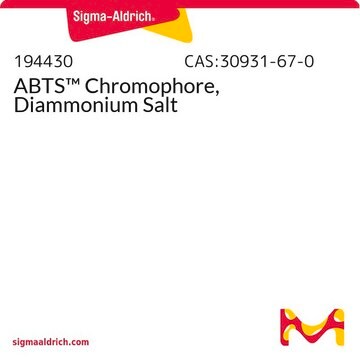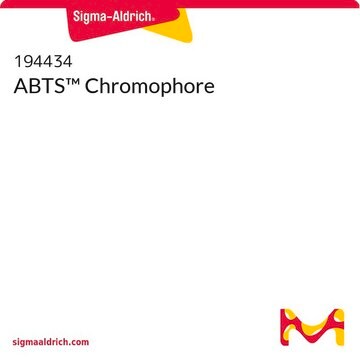This product has not been specifically tested for use in antioxidant assays. However, it has been used successfully as such in several publications. Please see the link below to review one example:
https://www.sciencedirect.com/science/article/pii/S0009912003002315?via%3Dihub
A3219
2,2′-azino-bis(acide 3-éthylbenzothiazoline-6-sulfonique)
peroxidase substrate, chromogenic, liquid
Synonyme(s) :
ABTS
Sélectionner une taille de conditionnement
134,00 €
Sélectionner une taille de conditionnement
About This Item
134,00 €
Produits recommandés
Nom du produit
2,2′-azino-bis(acide 3-éthylbenzothiazoline-6-sulfonique), Liquid Substrate System
Niveau de qualité
Forme
liquid
Température de stockage
2-8°C
Chaîne SMILES
CCN1C(\Sc2cc(ccc12)S(O)(=O)=O)=N\N=C3/Sc4cc(ccc4N3CC)S(O)(=O)=O
InChI
1S/C18H18N4O6S4/c1-3-21-13-7-5-11(31(23,24)25)9-15(13)29-17(21)19-20-18-22(4-2)14-8-6-12(32(26,27)28)10-16(14)30-18/h5-10H,3-4H2,1-2H3,(H,23,24,25)(H,26,27,28)/b19-17-,20-18-
Clé InChI
ZTOJFFHGPLIVKC-CLFAGFIQSA-N
Vous recherchez des produits similaires ? Visite Guide de comparaison des produits
Description générale
Application
Actions biochimiques/physiologiques
Forme physique
Code de la classe de stockage
10 - Combustible liquids
Classe de danger pour l'eau (WGK)
WGK 3
Point d'éclair (°F)
Not applicable
Point d'éclair (°C)
Not applicable
Faites votre choix parmi les versions les plus récentes :
Déjà en possession de ce produit ?
Retrouvez la documentation relative aux produits que vous avez récemment achetés dans la Bibliothèque de documents.
Les clients ont également consulté
Articles
NBT-BCIP substrate system aids in western blotting and immunohistological staining, producing a blue-purple insoluble end product.
-
Can this product be used for antioxidant assay?
1 answer-
Helpful?
-
-
What is the approximate concentration of H2O2 in the ready-to-use A3219 solution?
1 answer-
This product is no longer tested for hydrogen peroxide concentration. The previous specification for H2O2 was </= 0.03%. Current lots are expected to be within this range.
Helpful?
-
-
What is the molecular weight and density?
1 answer-
This product is a 1.8 mM solution of ABTS, the density is not determined. The solution is prepared from a diammonium salt form with a molecular weight of 548.60.
Please see the link below to review the product datasheet:
https://www.sigmaaldrich.com/deepweb/assets/sigmaaldrich/product/documents/338/745/a3219dat.pdfHelpful?
-
-
ABTS ready to use를 사용하여 항산화 실험을 하는경우 기존의 방법에 적용하면 어떤 단계가 생략이 되는건지 자세한 실험 과정을 알고 싶습니다
1 answer-
The only protocol currently available on the website is this data sheet: https://www.sigmaaldrich.com/deepweb/assets/sigmaaldrich/product/documents/338/745/a3219dat.pdf.
It may be helpful to also view the "Peer-Reviewed Papers" related to this product: https://www.sigmaaldrich.com/search/a3219?focus=papers&page=1&perpage=30&sort=relevance&term=a3219&type=citation_search.
Helpful?
-
-
Should Product A3219, 2,2´-Azino-bis(3-ethylbenzothiazoline-6-sulfonic acid), be diluted prior to use?
1 answer-
No, this product is offered as a ready-to-use (1×) solution.
Helpful?
-
-
What is the concentration of Product A3219, 2,2´-Azino-bis(3-ethylbenzothiazoline-6-sulfonic acid)?
1 answer-
The concentration of the ABTS is approximately 1.8 mM.
Helpful?
-
-
What is the Department of Transportation shipping information for this product?
1 answer-
Transportation information can be found in Section 14 of the product's (M)SDS.To access the shipping information for this material, use the link on the product detail page for the product.
Helpful?
-
-
When using Product A3219, 2,2´-Azino-bis(3-ethylbenzothiazoline-6-sulfonic acid), at what wavelength should the product of the reaction be measured?
1 answer-
The product should be measured at 405 nm. For end point assays, the reaction may be stopped with 1% (w/v) SDS and also read at 405 nm.
Helpful?
-
Active Filters
Notre équipe de scientifiques dispose d'une expérience dans tous les secteurs de la recherche, notamment en sciences de la vie, science des matériaux, synthèse chimique, chromatographie, analyse et dans de nombreux autres domaines..
Contacter notre Service technique









